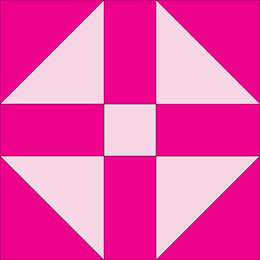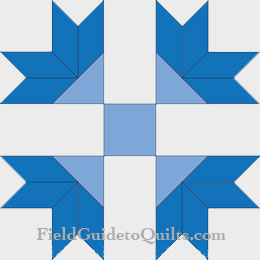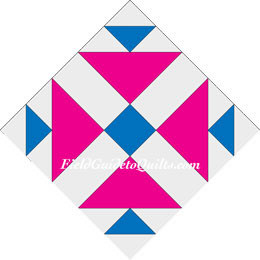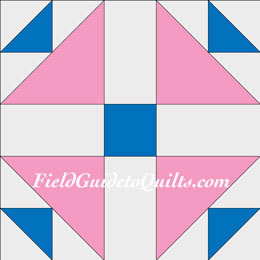An odd-numbered block often has a small square in the center and the look of a stylized four-leaf cloverleaf. These five-patch blocks are examples.
Grandmother's Choice
 Grandmother's Grandmother's
Choice
Mrs. Danner
1975
While this stripped-down design is probably as old as quilting itself, both Jinny Beyer and Barbara Brackman date it back to 1975, when it was published in a "Mrs. Danner" booklet. It's easy to recognize the design in other blocks on this page.
|

|
 |
Churn Dash and Butter Churn
The names "churn dash" and "churn dasher" make more sense when you look at the real thing.
To make butter, you would put milk in the churn and use the dash like a plunger, agitating the milk until the cream separated and hardened into butter. It took some time and muscle.
Farm women sold butter and eggs to neighbors and claimed their "egg-and-butter money" as pocket money.
There were a lot of different designs for butter churns, including churns that rocked like cradles, but the design at right was a familiar one.
Photos from coinsandmoreonline.com. Used with permission. |
|
|
|
Grandmother's Choice
 Grandmother's Grandmother's
Choice
Ladies Art Co., #129
1897
 The Ladies Art Company's #129, Grandmother's Choice, was published in 1897 and was reflected in many later designs. The Ladies Art Company's #129, Grandmother's Choice, was published in 1897 and was reflected in many later designs.
|
|
Duck's Foot
 Duck's Foot
Hearth & Home Duck's Foot
Hearth & Home
 The four-color Duck's Foot block at left is made from the same pattern as the LAC's Grandmother's Choice (above). Duck's Foot was published in Hearth & Home, according to quilt historian Barbara Brackman. The four-color Duck's Foot block at left is made from the same pattern as the LAC's Grandmother's Choice (above). Duck's Foot was published in Hearth & Home, according to quilt historian Barbara Brackman. |
|
A Wrench
 A Wrench
Louisville/Farm & Friends 1883 A Wrench
Louisville/Farm & Friends 1883
 The Ladies Art Company called this block Double Wrench in 1897 (#148), but Jinny Beyer found it under the name A Wrench in two 1883 magazines (Louisville and Farm and Friends).
We presume that "A" is the article of speech ("It's a bird—it's a plane—it's a wrench!") because there is no "B" wrench to be found. Call it B for Black Swan.
|
|
Churn Dash
 Churn Dash Churn Dash
 Churn Dash
Hall, 1935 Churn Dash
Hall, 1935
via
Havig, 1999
 The three-color Churn Dash is from Bettina Havig's Carrie Hall Blocks (American Quilter's Society, Paducah, KY, 1999). The pattern is identical to that of A Wrench, above; only the colors differ. The three-color Churn Dash is from Bettina Havig's Carrie Hall Blocks (American Quilter's Society, Paducah, KY, 1999). The pattern is identical to that of A Wrench, above; only the colors differ. |
|
Cross & Crown
 Cross & Crown
Ladies Art Co., #151 Cross & Crown
Ladies Art Co., #151
1897
This familiar block it is the LAC's #151, published in 1897.
The next time it made print was in Prairie Farmer (1928), followed by the Kansas City Star (1930), The Patchwork Book (1932) and Carrie Hall's The Romance of the Patchwork Quilt in America (1935).
|
|
Cross & Crown
 Cross & Crown
Kansas City Star Cross & Crown
Kansas City Star
1929
                         Cross & Crown (KCS) in three colors Cross & Crown (KCS) in three colors
|
|
Duck Paddle
 Duck Paddle Duck Paddle
Hall
1935
Duck Paddle was published in Carrie Hall's 1935 Romance of the Patchwork Quilt in America. Fanny's Fan was an alternative name. It looks, to our eyes, identical to Finley's block, and thus based on a 10x10 grid. Beyer's Quilter's Album uses a star grid.
The graphic at left is the one photographed in Hall's book. The photograph showed it on point. The background may have been white; we've pictured it in blue.
The block Hall stitched up for her collection—the block that appears in Havig's Carrie Hall Blocks—is different. Just skip down to the second "Fanny's Fan" to see it. |
|
Birds in the Air
 Birds in the Air
Little n' Big Birds in the Air
Little n' Big
1964
This block is simply one quarter of one of the blocks below with "Ducklings" in the name.
It's also a version of Birds in the Air and came from a 1964 publication called Little n' Big, as well as A Perfect Patchwork Primer (Gutcheon, 1973).
This is the most basic of the Birds in the Air blocks. Others have rows or groups of half-square triangles. Because this block is so often used as part of others, you can pretty much call it a building block.
While Flying Goose is an alternative name, it's so similar to Flying Geese, which is a much better known design, everybody we know of calls this block Birds in the Air. |
|
Duck & Ducklings
 Duck & Ducklings
Ladies Art Co., #245 Duck & Ducklings
Ladies Art Co., #245
1897
 The LAC's #245 is the oldest Duck & Ducklings block and the one most often pictured on the web. The LAC's #245 is the oldest Duck & Ducklings block and the one most often pictured on the web.
The name Monkey Wrench is from 1932 Farm Journal Quilt Patterns, according to Jinny Beyer's Quilter's Album of Patchwork Patterns (2009). The block does resemble other blocks called Monkey Wrench, but the name refers to so many different blocks that using it as an identifier is close to pointless. |
|
Ducks & Ducklings
                         Ducks & Ducklings (Finley) Ducks & Ducklings (Finley)
 Duck & Ducklings
Finley Duck & Ducklings
Finley
1929
Ruth Finley published this variation of Duck & Ducklings in 1929, along with both of the alternative names.
However, the name Corn & Beans is used for the design you'll find here (click!):  |
|
Ducks & Ducklings
 Ducks & Ducklings
KCS Ducks & Ducklings
KCS
1929
The Kansas City Star published Ducks & Ducklings with a contrasting center square in 1929. Carrie Hall added the other names in her 1935 book.
The center block creates a classic windowpane pattern.
|
|
Ducklings
 Ducks & Ducklings (KCS) Ducks & Ducklings (KCS)
 Ducklings
KCS Ducklings
KCS
1932 |
|
Ducklings for Friendship
 Ducks & Ducklings (KCS) Ducks & Ducklings (KCS)
 Ducklings for Friendship
KCS Ducklings for Friendship
KCS
1949 |
|
Goose in the Pond
 Goose in the Pond
LAC, #202 Goose in the Pond
LAC, #202
1897
The LAC's 1897 catalog included Goose in the Pond as #202. The second oldest name, Missouri Puzzle, was from Clara Stone's Practical Needlework (1906).
The whole quilt design is one of our favorites.
|
|
 |
|
 5-patch Churn Dash & more
5-patch Churn Dash & more
 5-patch Churn Dash & more
5-patch Churn Dash & more